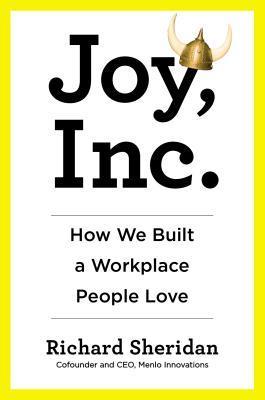Joy, Inc.How We Built A Workplace People Love
Richard Sheridan, Cofounder and CEO, Menlo Innovations
Preface to the Paperback Edition
“I do believe that we have an opportunity of a lifetime to make joy happen. As history has proved time and time again, it only takes a handful of folks with sincerity, passion, strategy, and a ready-to-do-whatever-it-takes attitude to win a battle against thousand-times-bigger bigger crowd of passive and self-focused individuals.”
Chapter One – My Journey to Joy
The Slide from Joy to Fear
The very next day, I told Bob that I would take the promotion and use the new role to build that “best damn software team”. Bob was very surprised by the 180-degree turn around in one evening, but he was supportive of renewed vigor. I’m sure neither of us knew at the time how far this journey was going to take us.
What I did know was that it wasn’t going to be easy. One particularly poignant moment in signing up for this greater responsibility was a parking lot conversation I had with Kimberly, a very talented leader who would now be working for me.
“Congratulations on your promotion to VP,” Kimberly begin. “Couldn’t have happened to a nicer guy.”
While her congratulations were sincere, I knew exactly what she meant. Nice won’t cut it here; you’ll be eaten alive. Good luck with that. I felt her good wishes in the pit of my stomach.
The next two years were the beginning of a journey back to self. Once again, I began to live out of my personal values at work. I spent more time with each member of my team, getting to know his or her hopes and desires for the future and sharing mine. I kept an open channel communication about what was going on at the executive level, and made individual expectations clear for the work that was needed. Things got better quickly but we’re still nowhere near good enough.
The First Experiments
I’ve come to realize that, in the face of a significant change initiative, emotional reactions fitting a standard bell curve will likely never create lasting change. You need the energy from the edges, not the middle.
A Critical Test of Leadership
Some even approach board members they knew well. But it was too late on all those fronts, as I had pre-sold all of my executive VP peers, my boss, the board, and even a couple of major stockholders on our new way of working. We were on our way.
Change Isn’t Easy
Change is never easy, but I wasn’t looking for easy change. I was looking for a meaningful change. I intrinsically understood what organizational change author Jeanenne LaMarch teaches in her books, including Changing the Way We Change. In order to get others to accept change, you must recognize that any change involves tearing down existing reward system, especially if those reward systems unintentionally foster and perpetuate pain-filled systems. If the change is to stick, you must quickly replace the old rewards with new rewards of equal or greater value (and remember, most treasured rewards are not monetary). Failure to establish new rewards will cause the team to revert to old forms in old rewards the first chance they get.
Chapter Two – Space and Noise
Drawing “Mobile” Inspiration from Fiction
M*A*S*H taught me that playfulness helped relive the tension of being in a war zone. Practical jokes, whimsy, and lack of respect for traditional authority of corporate culture keeps us energized and engaged. These qualities are amplified when you’re in an open, flexible, mobile space.
Joy is Noisy
They don’t remember the social butterfly next door who has everyone in the company stopping by for a coffee klatch. This drives them crazy and would drive me crazy, too. We don’t have that in Menlo. The conversations you hear are about problem solving or design challenges. A respectful underlying current of useful noise is quite easy to handle. The noise you hear in our office is the noise of work.
Most modern business projects are complex endeavors that require teams working together in tight collaboration. Noise and its energy breed collaboration and teamwork.
Chapter Three – Freedom to Learn
At Menlo, we don’t limit ourselves to specific technical knowledge. Our software developers have experience in a variety of programming language and readily choose the best technology for a given problem without being biased toward or needlessly faithful to a certain technology. This confounds most in our industry.
